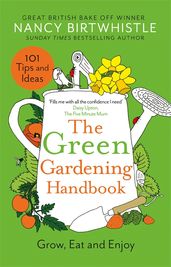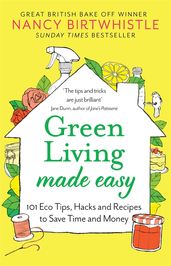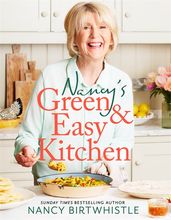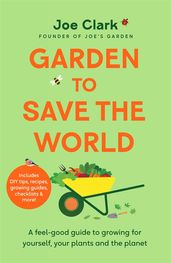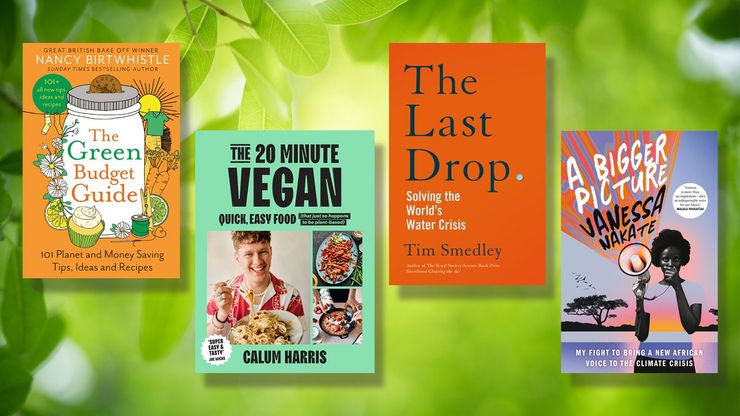Pure Magic: Nancy Birtwhistle shares her eco-friendly cleaning and gardening tips
Nancy Birtwhistle shares some of her favourite homemade, eco-friendly cleaning products and gardening tips, including the recipes for her natural cleaner – a.k.a ‘Pure magic’.
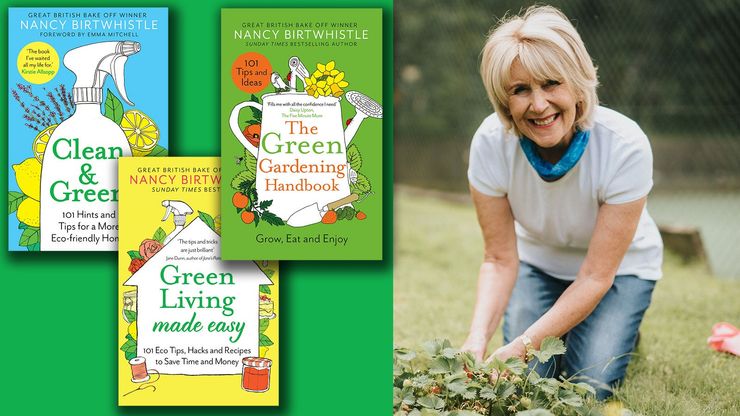
Nancy Birtwhistle not only won the fifth series of The Great British Bake-Off, but has built up a huge online following of devoted fans – including Gigi Hadid and Jonathan Van Ness – who love her sustainable, eco-friendly cleaning and gardening tips. Here she shares some of her cleaning recipes (including her famous 'Pure Magic' and cream cleaner) gardening suggestions (to give you a taste of Green Living Made Easy, Clean & Green and The Green Gardening Handbook), and eco-friendly tips for the summer, including how to remove suncream stains. Don't forget to have a read of our cooking and baking tips from Nancy Birthwhistle, too.
Nancy Birtwhistle’s 'Pure Magic' (previously known as 'Toilet Magic')
You will need
200g citric acid
150ml just-boiled water
20ml eco-friendly washing-up liquid
10–20 drops tea tree oil
1 pint measuring jug
Small whisk
400ml glass bottle with spray attachment and screw top
Place the measured crystals in a heatproof measuring jug and pour over just-boiled water. Stir until the liquid is clear and the crystals have dissolved, then simply add the eco-friendly washing-up liquid and tea tree oil and mix well using a small whisk. Leave the liquid in the jug to cool completely and uncovered for a few hours then pour into a spray bottle and it is ready to use.
Nancy Birtwhistle's citric acid wash to extend the shelf-life of fruit
You will need
Citric acid, lemon juice or white vinegar
Large heatproof bowl
Sieve or colander
Plastic box or glass jar with lid
Put 10g citric acid (about 2 teaspoons) in a large bowl, add 60ml (2fl oz) boiling water and swirl around until it dissolves and the liquid looks clear. Add 400ml (14fl oz) cold water. Wash the berries in the solution in batches, swirling them around and using a slotted spoon to remove them and place them in a sieve or colander to drain. Your berries are now cleaned and prepped for a longer, fresher life. There’s no need to wash them again before using.
Nancy Birtwhistle's kettle descaler
Do not dispose of the citric acid you used to extend the shelf-life of your fruit. Instead, use it to descale your kettle with this recipe.
You will need
80g citric acid for a thorough clean
1–2 lemons for regular maintenance
Half fill your kettle with water and boil. Unplug it, if electric, and stand the kettle in the empty sink (the citric acid will cause the water to bubble up). Add 80g citric acid and leave for half an hour. The limescale will dissolve. Pour away the liquid. Before pouring away the citric acid solution, tip the kettle on its side so that the water fills and dissolves any limescale build-up in the spout.
Nancy Birtwhistle's strawberry top vinegar
You will need
Knife
Large glass with a lid, sufficient to hold 500ml liquid plus strawberry tops
Strainer
Jug
500ml vinegar bottle
Funnel
Paper coffee filter or square of kitchen paper
Sliced green tops from a punnet of strawberries (about 20-30 tops)
500ml of distilled white vinegar
After washing your strawberries, rather than hull them, slice off the very tops of the leaves with a tiny section of the fruit. Pop the tops into a jar. Once all of the strawberries have strawberries have been trimmed and transferred into the jar, pour over the vinegar, screw on the lid and leave in a cool place (not the fridge) for 2-3 days.
After the standing time the vinegar will be tinged with a gorgeous strawberry colour and a fruity smell. Strain the vinegar from the tops using the strainer set over a jug.
Take your clean vinegar bottle, pop the funnel into the neck and line it with either the paper coffee filter or fold a sheet of absorbent kitchen paper into four and open it out into a cone. Then pour the strained vinegar through the filter and allow it to drop into the bottle.
Use in any recipe that calls for red wine vinegar, cider vinegar, white wine vinegar and use to make a simple vinaigrette for up to two months.
Nancy Birtwhistle's eco-friendly fabric conditioner
You will need
200ml (7fl oz) white vinegar or Freshen-up Vinegar
15ml (1 tbsp) vegetable glycerine
10 drops organic essential oil (try a flowery one such as ylang ylang or lily of the valley)
Mix and add 2–3 tablespoons to the fabric softener compartment for each wash.
Nancy Birtwhistle's cream cleaner
You will need
200g bicarbonate of soda
70ml vegetable glycerine
20ml eco-friendly washing-up liquid
a few drops essential oil for perfume (optional)
500ml jar or tub
Simply place all the ingredients into the jar or tub, stir to a thick smooth paste and it is ready to use. When making my first batch, I poured it into a reused plastic squeezy bottle, but I found that the cleaner was not free-flowing enough to run to the bottom of the bottle when nearly empty, so I now find a jar is much better. Perfect for granite worktops and sanitary ware, being non-acidic and only slightly abrasive.
Nancy Birtwhistle’s eco-friendly oven shelf cleaner
You will need
2–3 cups washing soda
Hot water
Sink or plastic box large enough to hold your oven shelves
In a sink large enough to take your oven shelves, or a sturdy plastic box, measure 2–3 cups of washing soda. If your shelves are really grubby, make a double concentrate and use 4–6 cups. Pour in sufficient boiling water to cover your shelves. If you do two shelves your water needs to be about 3 inches (7cm) deep.
Pop your metal shelves into the hot solution making sure they are submerged and leave them overnight.
I have found that if the shelves are hot when submerged the cleaning is quicker and more effective, but you may want to avoid shelves being too hot if you are using a plastic box.
The next day lift your shelves out of the brown, muddy water and wipe clean – that’s it.
You can pour the water down the drain knowing no harm is being done.
Note: If your oven shelves have been sprayed or coated with ‘self-clean’ substances, do not use this method. The chemical coating can be damaged by soaking. This method is not suitable for aluminium trays or shelves. Aluminium can be cleaned using bicarb or washing soda, but long soaks cause oxidization.
Nancy Birtwhistle’s eco-friendly carpet stain remover
You will need
Bicarbonate of soda
Warm water
Small bowl
Cloth
Mix a thin paste and dab it over the stain, massaging it in circular motions with gloved hands. The residual stain will lift and so will the odour. If you can air-dry the item, even better.
Note: When dealing with carpet stains, never be tempted to give the carpet a vigorous rub and scrub because this can damage the pile. I speak from experience here, as I once dived straight onto a stain with a cloth and a full jar of elbow grease. I rubbed and scrubbed at this stain, only to find when everything had dried that the stain had disappeared but was replaced by a permanently damaged scuffed carpet pile. Remember: however bad the stain, gently does it.
Nancy Birtwhistle’s shrunken jumper fix
You will need
A large bowl
The shrunken jumper
Hair conditioner
2 tbsp white vinegar
2 large ‘bath-size’ clean dry towels
In a bowl large enough to take the woollen jumper when folded, give 2–3 squirts of hair conditioner and add the vinegar then fill with lukewarm water. Lay the folded jumper onto the bowl of water. No need to submerge it – leave it to absorb the water in its own time and sink to the bottom of the bowl, then leave overnight. The vinegar and hair conditioner will soften the woollen fibres, making them lax and pliable. The next day, pour the water off the jumper and gently squeeze it to remove the excess. Do not rinse, wring or spin.
The next day, pour the water off the jumper and gently squeeze it to remove the excess. Do not rinse, wring or spin. Lay a large clean towel onto a flat surface and on top place the very wet jumper. Gently pull at it lengthways and sideways, stretching the fibres as you go. Take your time in gently remoulding your favourite jumper to its original size and shape.
Once you are satisfied that it looks as it used to, take the towel and start rolling from the bottom, nice and tight, until the jumper is concealed in a huge towel and jumper sausage. Rolling tightly will extract much of the remaining moisture. When the towel feels quite wet, unroll and transfer the jumper to the second towel, which again has been laid out on a flat surface.
Nancy Birtwhistle’s plant feed with added benefit
Makes around 500ml. You will need
Rubber gloves
Scissors
60g nettles (leaves and stalks)
Clean, old plastic tub or similar with a lid
600ml cold water (rainwater is ideal)
Old fine tea strainer
1-litre bottle with spray attachment
1 – 2 drops eco-friendly washing-up liquid
6 drops clove-bud oil
Wearing gloves, harvest the nettles with scissors. Select the young leaves because they contain more nitrogen that is quickly broken down in water. The leaves need to be 5 – 7 cm long. Pop them into a plastic tub that has a lid. Pour over the cold water, stir and push the nettles into the water using a gloved hand. Pop the lid on and leave outside and forget about it for at least a week (2 weeks is even better), stirring maybe once or twice during that time.
When ready to use (and I suggest you do this outside), take off the lid, give it a stir and the smell will send you reeling – it really is awful, but plants love it! Strain off the leaves, using simply the lid as an aid, then strain again using an old fine tea strainer. Fill the spray bottle, then add the eco-friendly washing-up liquid and clove-bud oil. Give it a good shake then spray away!
I avoid using this spray on my vegetables just before I want to eat them, though the spray will readily wash off so it's not a big deal if you do.
Nancy Birtwhistle's eco-friendly wet wipes
You will need
20 x 6-8 inch squares thin cotton fabric scraps
20ml aloe vera gel (mild cleanser and skin moisturiser)
120ml water
30ml surgical spirit (anti bac cleanser)
2-3 drops lemon essential oil (for fragrance – optional)
Small plastic box with airtight lid
Small plastic bag
Small whisk
Two bowls – one of cold water and one to mix ingredients
After cutting the fabric squares wet them with cold water and wring them out so that not a single drop of water can be squeezed out. In the bowl add the aloe vera gel and a little water at a time until the thick gel becomes a runny solution. Add the surgical spirit – stir then add the fabric pieces. Squeeze them out and fold into the box, cover with the folded plastic bag and replace with a lid. The plastic bag is for adding the soiled ones to bring home to wash.
These will keep wet and fresh for at least six months – I keep a box in the car.
Nancy Birtwhistle's travel wash
You will need
500ml used and washed plastic bottle
15g grated soap or soap flakes
20g washing soda
2-3 drops eco washing-up liquid
Place all of the ingredients into a small bottle. When you arrive to your holiday – fill the bottle with just warm water – give it a good shake then it is ready to use.
Not only is this better for the planet than single-use plastic, but it also prevents leakages when you're travelling!
Nancy Birtwhistle's suncream stain remover
You will need
T-shirt
Bicarbonate of soda and teaspoon in a bowl
Water spray bottle
Eco washing-up liquid in a small bowl
Plastic bag
Rather than reach for the harmful and often expensive biological detergents and stain removal products that can sometimes make the stain worse, try this simple paste.
Wet the stain slightly and add a teaspoon or two of bicarbonate of soda. Drizzle over the eco-friendly washing-up liquid and massage in using your hands. Pop the item into a plastic bag so that it doesn’t dry out and leave overnight.
The next day, put your item into the washing machine – no need to rinse it off – on a long, cool twenty-degree wash cycle.
Nancy Birtwhistle's books
The Green Budget Guide
by Nancy Birtwhistle
Pure Magic: The Green Budget Guide by Nancy Birtwhistle, the Sunday Times bestselling author and Great British Bake Off winner, provides valuable advice on maintaining an economical, eco-friendly home. Drawing from her experiences growing up post-war, being a working single mother, and creating budget-friendly hacks such as her 12p laundry detergent, Nancy shares 101 useful, cost-effective, and environmentally conscious household tips. From removing stubborn stains to cookery and mould remediation, this guide is here to help run a household efficiently, while also cherishing our planet.
Clean & Green
by Nancy Birtwhistle
This beautifully illustrated black and white guide contains 101 hints, tips and hacks to help you take small steps at home which will have a big environmental impact. Nancy Birtwhistle shares the simple recipes and methods she has developed since making a conscious effort to live more sustainably, from everyday cleaning and laundry tips to easy oven-cleaner and stain removal tips. These tried-and-tested recipes (including her Pure Magic cleaning spray) will keep both your home and the planet clean and green for future generations.
The Green Gardening Handbook
by Nancy Birtwhistle
Going green in the garden has never been easier with Nancy Birtwhistle’s sustainable, eco-friendly tips that will help you make the most of your space, and what it can grow. Whether you have a sprawling garden, a modest patch of grass or just a spare windowsill, The Green Gardening Handbook has over 100 tips will help you embrace the joy of growing and eating from your own garden.
Green Living Made Easy
by Nancy Birtwhistle
We all want to do our best for our homes and the planet, but it’s often hard to find the time and energy to think of alternatives. Nancy Birtwhistle makes it easy with 101 indispensable tips, ideas and recipes that will help you to live a more eco-friendly life without giving up on any home comforts.
This practical book from Sunday Times bestselling author and Great British Bake Off winner Nancy Birtwhistle is the ultimate guide to reducing your environmental impact while saving you time and money. Inside are tips and home hacks on everything from eco cleaning, upcycling and making the most out of your weekly shop to small-space gardening and creative crafts, plus a selection of Nancy's delicious recipes.
Sizzle & Drizzle
by Nancy Birtwhistle
All the practical baking knowledge you need from Nancy Birtwhistle, with this green edition of her first ever cookbook. Want to learn more about making different kinds of pastry? Or perhaps you’ve always wanted to try your hand at preserving food? Looking for some free-from options? Nancy has you covered. In true Nancy style, Sizzle & Drizzle is brimming with top tips for cooking, budget-friendly hacks and even includes QR codes linking to videos of Nancy making the dishes.
Green and Easy Kitchen
by Nancy Birtwhistle
Nancy Birtwhistle shows us how to cook and eat in a sustainable and budget-friendly way, from batch-cooking the basics to avoid ultra-processed food to great ideas for leftovers. From stocks, soups and preserves, to weekday family meals and celebration dinners – and a bit of everything in between – Nancy has you covered in the kitchen with plenty of solutions for a greener way of life without breaking the bank.
Who is Nancy Birtwhistle?
Inspired to protect the planet for her ten grandchildren, Nancy decided to change how she used single-use plastic and chemicals in her home and began to share her environmentally friendly, innovative ideas and time-saving swaps with her followers.
Now Nancy is sharing her tried and tested tips in her books Clean & Green and Green Living Made Easy. Clean & Green is full of natural cleaning ideas and home-made eco-friendly cleaning products, many of which are faster and easier than the go-to products and methods most of us use now. Green Living Made Easy contains 100+ tips on how to live a more eco-friendly life without giving up on any home comforts.
You also might like . . .
Garden to Save the World
by Joe Clark
Joe Clark, gardening expert and social media sensation, presents Garden to Save the World. He aims to help you make the most of the outdoors, whether or not you have a garden of your own by providing tips on zero waste, sustainable garden setups, interaction with wildlife, and more. This inclusive guide has practical takeaways: use your garden as a supermarket, set up an urban bee hotel, and cook delicious recipes. Perfect for both budding and advanced nature enthusiasts, the man behind @Joesgarden is here to help you live more sustainably.
Photo credit: ©Elizabeth Clarke, Pink Feet


